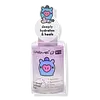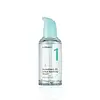What's inside
What's inside
 Key Ingredients
Key Ingredients

 Benefits
Benefits

 Concerns
Concerns

No concerns
 Ingredients Side-by-side
Ingredients Side-by-side

Water
Skin ConditioningGlycerin
HumectantButylene Glycol
HumectantMethyl Gluceth-20
Humectant1,2-Hexanediol
Skin ConditioningHyaluronic Acid
HumectantCentella Asiatica Extract
CleansingSpirulina Platensis Extract
Skin ProtectingIllicium Verum Fruit Extract
PerfumingSimmondsia Chinensis Seed Oil
EmollientAsiaticoside
AntioxidantMadecassic Acid
Skin ConditioningAsiatic Acid
Skin ConditioningMadecassoside
AntioxidantBiosaccharide Gum-1
HumectantBetaine
HumectantCarbomer
Emulsion StabilisingArginine
MaskingGlyceryl Acrylate/Acrylic Acid Copolymer
HumectantPvm/Ma Copolymer
Emulsion StabilisingHydrogenated Phosphatidylcholine
EmulsifyingCaprylic/Capric Triglyceride
MaskingSucrose Stearate
EmollientCetearyl Alcohol
EmollientPEG-60 Hydrogenated Castor Oil
EmulsifyingCaprylyl Glycol
EmollientEthylhexylglycerin
Skin ConditioningAllantoin
Skin ConditioningDisodium EDTA
Parfum
MaskingWater, Glycerin, Butylene Glycol, Methyl Gluceth-20, 1,2-Hexanediol, Hyaluronic Acid, Centella Asiatica Extract, Spirulina Platensis Extract, Illicium Verum Fruit Extract, Simmondsia Chinensis Seed Oil, Asiaticoside, Madecassic Acid, Asiatic Acid, Madecassoside, Biosaccharide Gum-1, Betaine, Carbomer, Arginine, Glyceryl Acrylate/Acrylic Acid Copolymer, Pvm/Ma Copolymer, Hydrogenated Phosphatidylcholine, Caprylic/Capric Triglyceride, Sucrose Stearate, Cetearyl Alcohol, PEG-60 Hydrogenated Castor Oil, Caprylyl Glycol, Ethylhexylglycerin, Allantoin, Disodium EDTA, Parfum
Water
Skin ConditioningButylene Glycol
HumectantNiacinamide
SmoothingGlycerin
HumectantDipropylene Glycol
Humectant1,2-Hexanediol
Skin ConditioningPanthenol
Skin ConditioningSophora Angustifolia Root Extract
Skin ConditioningAcrylates/C10-30 Alkyl Acrylate Crosspolymer
Emulsion StabilisingPropanediol
SolventDiethoxyethyl Succinate
SolventTromethamine
BufferingHydrogenated Lecithin
EmulsifyingAmmonium Acryloyldimethyltaurate/Vp Copolymer
Betaine
HumectantPantothenic Acid
Skin ConditioningTrehalose
HumectantEthylhexylglycerin
Skin ConditioningGlyceryl Oleate
EmollientSodium Phytate
Allantoin
Skin ConditioningAlpha-Arbutin
AntioxidantHouttuynia Cordata Extract
Skin ConditioningLauryl Glucoside
CleansingMyristyl Glucoside
CleansingPolyglyceryl-6 Laurate
EmulsifyingZinc PCA
HumectantMelia Azadirachta Leaf Extract
Skin ConditioningTocopherol
AntioxidantGlycyrrhiza Uralensis Root Extract
Skin ConditioningMelia Azadirachta Flower Extract
Skin ConditioningCoccinia Indica Fruit Extract
Skin ConditioningCentella Asiatica Extract
CleansingSodium Hyaluronate
HumectantCitric Acid
BufferingSolanum Melongena Fruit Extract
Skin ConditioningBeta-Glucan
Skin ConditioningOcimum Sanctum Leaf Extract
Skin ConditioningHyaluronic Acid
HumectantDecyl Glucoside
CleansingCurcuma Longa Root Extract
MaskingCorallina Officinalis Extract
Skin ConditioningDipotassium Glycyrrhizate
HumectantHydrolyzed Hyaluronic Acid
HumectantSimmondsia Chinensis Seed Oil
EmollientCamellia Sinensis Leaf Extract
AntimicrobialCentella Asiatica Leaf Extract
Skin ConditioningCladosiphon Okamuranus Extract
Skin ConditioningSalix Alba Bark Extract
AstringentSodium Acetylated Hyaluronate
HumectantCoffea Arabica Seed Extract
MaskingBeta-Sitosterol
Emulsion StabilisingPolyglyceryl-10 Stearate
Skin ConditioningCitrus Aurantium Bergamia Leaf Extract
AstringentPinus Densiflora Leaf Extract
AntimicrobialWater, Butylene Glycol, Niacinamide, Glycerin, Dipropylene Glycol, 1,2-Hexanediol, Panthenol, Sophora Angustifolia Root Extract, Acrylates/C10-30 Alkyl Acrylate Crosspolymer, Propanediol, Diethoxyethyl Succinate, Tromethamine, Hydrogenated Lecithin, Ammonium Acryloyldimethyltaurate/Vp Copolymer, Betaine, Pantothenic Acid, Trehalose, Ethylhexylglycerin, Glyceryl Oleate, Sodium Phytate, Allantoin, Alpha-Arbutin, Houttuynia Cordata Extract, Lauryl Glucoside, Myristyl Glucoside, Polyglyceryl-6 Laurate, Zinc PCA, Melia Azadirachta Leaf Extract, Tocopherol, Glycyrrhiza Uralensis Root Extract, Melia Azadirachta Flower Extract, Coccinia Indica Fruit Extract, Centella Asiatica Extract, Sodium Hyaluronate, Citric Acid, Solanum Melongena Fruit Extract, Beta-Glucan, Ocimum Sanctum Leaf Extract, Hyaluronic Acid, Decyl Glucoside, Curcuma Longa Root Extract, Corallina Officinalis Extract, Dipotassium Glycyrrhizate, Hydrolyzed Hyaluronic Acid, Simmondsia Chinensis Seed Oil, Camellia Sinensis Leaf Extract, Centella Asiatica Leaf Extract, Cladosiphon Okamuranus Extract, Salix Alba Bark Extract, Sodium Acetylated Hyaluronate, Coffea Arabica Seed Extract, Beta-Sitosterol, Polyglyceryl-10 Stearate, Citrus Aurantium Bergamia Leaf Extract, Pinus Densiflora Leaf Extract
 Reviews
Reviews

Ingredients Explained
These ingredients are found in both products.
Ingredients higher up in an ingredient list are typically present in a larger amount.
1,2-Hexanediol is a synthetic liquid and another multi-functional powerhouse.
It is a:
- Humectant, drawing moisture into the skin
- Emollient, helping to soften skin
- Solvent, dispersing and stabilizing formulas
- Preservative booster, enhancing the antimicrobial activity of other preservatives
Allantoin is a soothing ingredient known for its protective and moisturizingg properties. Because of this, it is often added to products with strong active ingredients.
Studies show higher concentrations of this ingredient can promote wound healing.
Though it can be derived from the comfrey plant, allantoin is produced synthetically for cosmetic products to ensure purity.
Learn more about AllantoinBetaine is a common humectant (a substance that promotes retention of moisture). It's known to be gentle on the skin and can help balance hydration.
This ingredient is best for improving hydration and soothing irritated skin. Studies also show it helps even out skin tone.
Fun fact: Betaine is naturally created in the skin and body. The kind found within cosmetic products can be either plant-derived or synthetic.
Another name for betaine is trimethylglycine.
Learn more about BetaineButylene Glycol (or BG) is used within cosmetic products for a few different reasons:
Overall, Butylene Glycol is a safe and well-rounded ingredient that works well with other ingredients.
Though this ingredient works well with most skin types, some people with sensitive skin may experience a reaction such as allergic rashes, closed comedones, or itchiness.
Learn more about Butylene GlycolCentella Asiatica Extract (Centella) is derived from an herb native to Southeast Asia. It is famous for its anti-inflammatory and soothing properties.
Centella is rich in antioxidants and amino acids, such as Madecassic Acid and Asiaticoside.
Studies show the compounds in centella help with:
The combination of all these properties makes centella effective at soothing, hydrating, and protecting the skin.
Other great components of centella include Vitamin A, vitamin C, several B vitamins, and Asiatic Acid.
Fun fact: Centella has been used as a medicine and in food for many centuries. As a medicine, it is used to treat burns, scratches, and wounds.
Learn more about Centella Asiatica ExtractEthylhexylglycerin (we can't pronounce this either) is commonly used as a preservative and skin softener. It is derived from glyceryl.
You might see Ethylhexylglycerin often paired with other preservatives such as phenoxyethanol. Ethylhexylglycerin has been found to increase the effectiveness of these other preservatives.
Glycerin is already naturally found in your skin. It helps moisturize and protect your skin.
A study from 2016 found glycerin to be more effective as a humectant than AHAs and hyaluronic acid.
As a humectant, it helps the skin stay hydrated by pulling moisture to your skin. The low molecular weight of glycerin allows it to pull moisture into the deeper layers of your skin.
Hydrated skin improves your skin barrier; Your skin barrier helps protect against irritants and bacteria.
Glycerin has also been found to have antimicrobial and antiviral properties. Due to these properties, glycerin is often used in wound and burn treatments.
In cosmetics, glycerin is usually derived from plants such as soybean or palm. However, it can also be sourced from animals, such as tallow or animal fat.
This ingredient is organic, colorless, odorless, and non-toxic.
Glycerin is the name for this ingredient in American English. British English uses Glycerol/Glycerine.
Learn more about GlycerinHyaluronic acid is naturally found in healthy skin. It is a humectant, meaning it draws moisture to your skin.
This ingredient helps hydrate, soothe, and protect the skin.
What makes hyaluronic acid so hydrating? It has the capacity to bind or hold large amounts of water.
Fun fact: It is already naturally found in our bodies, such as the fluids of our eyes and our joints.
Studies find this ingredient to have anti-inflammatory and anti-microbial properties. This can help speed up wound-healing.
Hyaluronic acid can be irritating if the molecule has a low-molecular weight, or if the molecules are small.
One study found low-molecular weight hyaluronic acid to be pro-inflammatory, meaning some people may experience irritation. This is because our bodies use hyaluronic acid in the wound-healing process to signal to our bodies, via irritation, that something needs healing.
The same study found high-molecular weight hyaluronic acid to be anti-inflammatory.
These are some other common types of Hyaluronic Acid:
Learn more about Hyaluronic AcidThis oil comes from the seeds of the desert shrub called Jojoba. It is more commonly known as jojoba oil, a non-comedogenic oil.
Jojoba oil does not contain fragrance and has many fatty-acids, making it a great soothing ingredient.
It also contains Vitamin E, a great moisturizing ingredient. Vitamin E is also an antioxidant and protects your skin against oxidative damage.
This ingredient humectant properties, meaning it helps draw moisture from the air. This helps keep your skin hydrated.
While jojoba has antibacterial properties, it is only able to kill some strains of bacteria.
Studies also show it helps in wound healing. In fact, Indigenous cultures have used jojoba as a moisturizer and to help treat burns for centuries.
Fun fact: Jojoba oil similar to natural human skin sebum, so it has a great effect on dry skin. It is also promising with helping to regulate sebum production.
Due to its fatty acid content, Jojoba oil may not be fungal acne safe. We recommend speaking with a professional if you have any concerns.
Learn more about Simmondsia Chinensis Seed OilWater. It's the most common cosmetic ingredient of all. You'll usually see it at the top of ingredient lists, meaning that it makes up the largest part of the product.
So why is it so popular? Water most often acts as a solvent - this means that it helps dissolve other ingredients into the formulation.
You'll also recognize water as that liquid we all need to stay alive. If you see this, drink a glass of water. Stay hydrated!
Learn more about Water